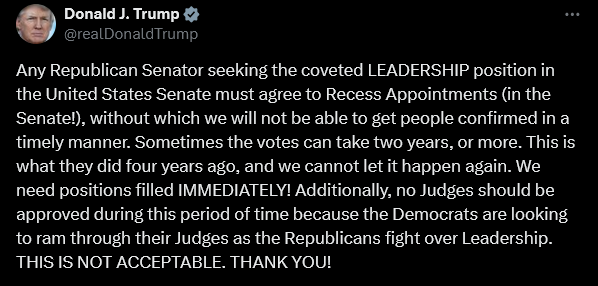The dust was yet to settle from President Donald J. Trump’s historic win in the 2024 Presidential Election before news began circulating about the potential need for “recess appointments” during Trump’s second term of office. What brought the issue to the forefront so quickly was the GOP winning enough seats in the elections to take control of the US Senate and the need to select a new GOP Senate Majority Leader. The vote on the new GOP Senate Leadership was held on November 13, 2024. In a message posted across his social media platforms on November 10, 2024, President Trump made clear any GOP leader in the US Senate must support recess appointments:
But, what are “recess appointments” and why is this issue so important to President Trump? A “recess appointment” is simply an appointment made by a President to fill a vacant position while the Senate is in recess (meaning the body is not convened or doing business). These appointments are made without the US Senate confirming the person being appointed. Let’s take a closer look.
The Appointments Clause of the US Constitution
The power of the President of the United States to make appointments to various different federal government positions is found in the United States Constitution’s Appointments Clause (Article II, Section 2, Clause 2) which provides:
This clause provides the President “shall nominate, and by and with the Advice and Consent of the Senate, shall appoint Ambassadors, other public ministers and Consuls, Judges of the supreme Court, and for all other Officers of the United States . . .,” subject to the “Advice and Consent of the Senate.”
The Appointments Clause also authorizes the Congress to grant the President power to appoint “inferior Officers” at his own discretion.
Federal law contains a vast number of statutory provisions regarding Presidential executive appointments and Senate confirmation as well as provisions pertaining to a host of offices the President may fill by appointment without Senate confirmation. An incoming President will have about 4,000 positions to fill by appointment and over 1,000 require Senate confirmation.
This 2024 article from the University of Chicago, Center for Effective Government highlights how delays in obtaining Senate confirmation continue to get longer and longer over time extending from an estimated 56 days in the Reagan Administration in the 1980s to over twice that long during Trump’s first term.
In fact in President Trump’s first term, Democrats used parliamentary tricks in the US Senate to nearly grind confirmation of President Trump's appointees to a halt. The delay tactics harmed Trump’s ability to govern. As US Senator Roy Blunt (R-MO) told The New York Times in 2017:
This is where “recess appointments” come in.
The Recess Appointment Clause
A “recess appointment” is a specific appointment power provided by the Constitution. The Recess Appointments Clause (Article II, Section 2, Clause 3) provides:
Simply stated, a “recess appointment” is an appointment made by the President of the United States to fill a vacant position while the Senate is in recess. Such appointments are made without Senate confirmation, but expire at the end of the next session of Congress.
The United States Supreme Court’s opinion in NLRB v. Canning (2014) confirms a Senate “recess” may occur between Sessions of Congress or during a Session of Congress (known as an “intra-session recess”), provided the recess during Session is of at least 10 days duration. (SCOTUS also confirmed in NLRV v. Canning the President could fill all vacancies in offices, whether the vacancy existed before the recess or if it arose after the recess.)
President Trump was unable to make “recess appointments” in his first term
President Trump is interested in “recess appointments” now, because despite the fact the Democrats stonewalled his executive nominees in his first term, he was not able to make any “recess appointments.” None. Zero. While President Obama, President Bush 43 and President Clinton made 32, 171 and 139 “recess appointments” respectively, President Trump was unable to make any at all. President Trump’s inability to make recess appointments in his first term was due to a combination of parliamentary “dirty tricks” by then GOP Senate Majority Leader Mitch McConnell, and the Democrats.
Will Trump make any recess appointments this time around?
Time will tell, but probably so. Article I, Section 5, Clause 4 of the Constitution require both the House and Senate to agree on adjournments of more than three (3) days during a Session. And NLRB v. Canning requires an intra-session recess to be at least ten (10) days for the Recess Appointment power to be used validly. Since Congress is in Session most of the year in modern times, both House and Senate will need to agree to adjourn for ten days or more. But, with the GOP in control of both Houses of Congress the potential for such an adjournment is much greater than if Democrats controlled one or the other.
In fact, President Trump may have the opportunity to put Congress into adjournment using his own constitutionally-granted power.
Article II, Section 3 of the United States Constitution grants the President of the United States the power to adjourn Congress himself:
This requires both Houses of Congress (the House and Senate) to be in disagreement over adjournment. My research reflects this power has not previously been exercised by any sitting President in the history of this Country, though the Constitution clearly provides for this presidential power.
Under the circumstances, President Trump will probably get the opportunity to make “recess appointments” in his second term, though, for my part, I doubt recess appointments will be made for more significant offices or positions.
President Trump’s Other Options to Fill Vacancies are Limited
Even in the absence of recess appointments, another option afforded the President of the United States to fill positions requiring US Senate confirmation is the Federal Vacancies Reform Act of 1998 or FVRA, though this option is limited. Under this law, the President may fill some vacancies in positions requiring US Senate confirmation by appointing other individuals in the federal government who hold positions for which they were previously confirmed by the US Senate or the President may appoint another acting official of the relevant agency if that person is of a certain rate (GS-15, which is the highest grade for federal employees). The person generally may only serve in the position for 210 days.
This law does NOT allow a person who is nominated to fill the vacant position to be appointed by the President under the FVRA to fill the position. The United States Supreme Court confirmed this interpretation of the law in a case decided in 2017 (involving appointments made by President Obama under the FVRA).
Thus, this law essentially limits the President to elevating existing federal office holders or long-term government employees to fill vacanies in offices requiring US Senate confirmation. This is not much of an option for an incoming President who wants to “shake things up” in Washington.
Conclusion
The GOP Senate majority is thin, consisting of 53 votes as of this writing. Several of those GOP Senators are uniparty, globalist, anti-Trump decepticons (GOP Senators McConnell and Murkowski come to mind immediately) who will likely thwart President Trump’s more effective appointments. While the ability to make recess appointments could prove crucial to President Trump’s ability to fill some cabinet positions and agency leadership positions, I doubt the current US Senate leadership will allow the Senate to adjourn if President Trump plans to use recess appointments to appoint office holders who would not get Senate confirmation.
American voters spoke loud and clear in November. They want President Trump to have the chance to implement his policies. Recess appointments could prove crucial to his ability to implement those policies. President Trump should be able to use recess appointments to fill the important vacancies, but given the GOP leadership in the Senate, don’t expect important offices such as Secretary of State, Secretary of Defense, etc…, to be filled in this manner. Time will tell.
(My new book Fake News Exposed: 25 of the Worst Media Lies about Conservatives, Guns, COVID and Everything Else is out at Amazon. You may also pick up a copy of one of my other books at Amazon as well.)










Your explanation makes it easier for me to get a better understanding of government policy.